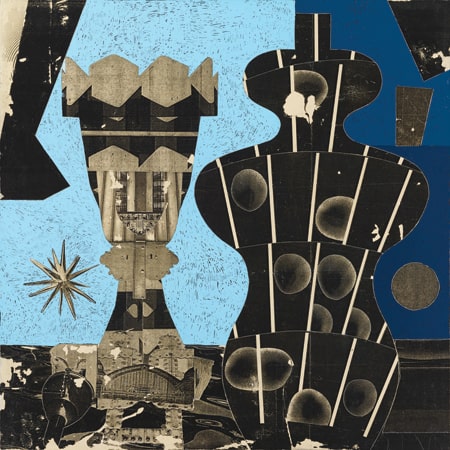
“Basel Blue,” 2016, Gouache over acrylic toner transfer on panel, 24″ x 24″
Photo: courtesy Gallery 16
Seattle-based artist Robert Hardgrave’s elegant mixed-media works might appear to have been created by a reserved and urbane artist, one perhaps with deep roots in academia. It’s not until he reveals his fondness for “Doom metal… it’s raw, just aggressive… and nasty, ” that it becomes clear there is more to this soft-spoken, personable fellow than first meets the eye. Born in Oxnard, CA, the artist moved with his family to Southern Arizona at the age of 10. A rebellious teenager, Hardgrave was heavily into skateboarding, motorcycles and Metal music-pursuits that did not mesh well with his fundamentally religious family. When an early marriage failed, a visiting friend suggested that he join him in Seattle.
His buddy, as it turned out, loved to draw. “He was drawing all the time, so I drew too. ” One benefit of Hardgrave’s “Bible-beating ” education in a tiny, religious secondary school was that he ended up being the only student in a top-notch art class covering technique and art history. Spending two years in Monterey, CA, Hardgrave took art classes at the community college, and when he settled in Washington he pursued a two-year design program culminating in a degree-shortly followed by the devastating discovery that he was in kidney failure.
While working at the Symphony Hall in Seattle, he befriended the woman he eventually married, who would stand by him through his illness and subsequent difficult recovery. His kidney transplant was successful, but was dealt a second blow when he discovered he had contracted Non-Hodgkin’s lymphoma in the donated kidney. Once he recovered from this ordeal, he became focused on expressing his unique and personal artistic vision in an unrestrained manner.
Early works in ballpoint pen, “kind of glorified doodles, ” evolved into complex, mixed-media pieces often infused with the energy of his early, wilder days. Using a highly saturated palette and intricate fields of pattern, the artist created large-scale paintings with a hallucinatory vibe. Some of these works have a smooth, almost airbrushed appearance, Léger channeled through Peter Saul, perhaps, with others evoking Kandinsky and the Bauhaus.
A prolonged journey into the realm of textiles was sparked by an impulse to recycle some earlier, “failed ” paintings by ripping up old canvases and then sewing them back together. The stitching took on a life of its own, and the artist explored drawing with the sewing machine. Hardgrave also created a piece designed to be worn, Rapture Suit (2010) which tellingly featured no opening for the head-those awaiting salvation in the form of a swift ascent to heaven as the world ends would, apparently, proceed blindly.
With his difficult health history, and the challenges faced during the economic downturn, Hardgrave found himself feeling a bit low. “I was a little bitter. ” Working with a therapist proved invaluable in overcoming this dark period. Once he “stopped playing those old tapes in my head, ” opportunities began to materialize. “It kind of snowballed, ” he says, somewhat incredulously. As word about Hardgrave spread, he has twice been nominated for the Cornish College of the Arts Neddy Award, named for Seattle artist and teacher Robert E. “Ned ” Behnke (1948-1989), and also been nominated for the 2014 Portland Art Museum’s Contemporary Northwest Arts Awards.
Hardgrave’s recent exhibition “Blues Blues, Slower than my Heartbeat, ” at Gallery 16 in San Francisco, consisted of 15 medium-to-large-scale works on mulberry paper, all incorporating the Xerox transfer print process. Blues, Blues … (2016) is the title work of the exhibition. “The lines represent bars of music, and that was my initial concept, to build the imagery with what the music felt like to me… ” The “blues ” inflecting the work is filtered through his Doom metal lens, “metal coming out of rock and roll, and rock and roll coming from the blues. It’s kind of sad, and introspective. ” Circles and roughly rectangular geometric forms and graffiti-like squiggles in violets, pinks and orange join imagery ranging from ships, a train trestle and plumbing, on a slate gray ground.
Doomsayer (2016), a large, loosely figurative work in pink and gray, was inspired by the work of Goya at the Prado in Madrid-Hardgrave mounted an exhibition at Swinton & Grant Gallery in Madrid in 2015, completing as well a whirlwind tour of Switzerland. A striking work in shades of blue and gray, Basel Blue (2016), features figurative or vase-like elements thrusting upward, disrupted by passages of piercing sky-blue gouache.
“One of my goals in making art is to inspire people to make their own, ” he states. “And not to be afraid to try new things… new media. ” His enthusiasm is infectious, “I wake up just excited to be in my studio. ” Rejecting the narrow definition of lifestyle offered by fundamentalism, Hardgrave has embraced a new faith: “art ” he explains, “is my religion. ”
“Robert Hardgrave: Blues Blues, Slower than my Heart Beat, ” was on view at Gallery 16, in San Francisco, from July 8 – August 31, 2016.
Lead Image:
Photo of the artist: Graham Holoch